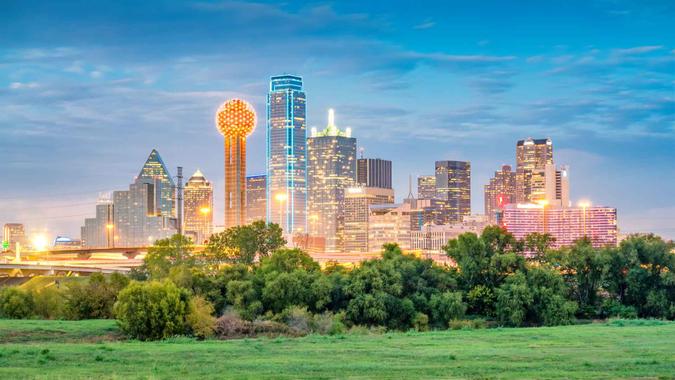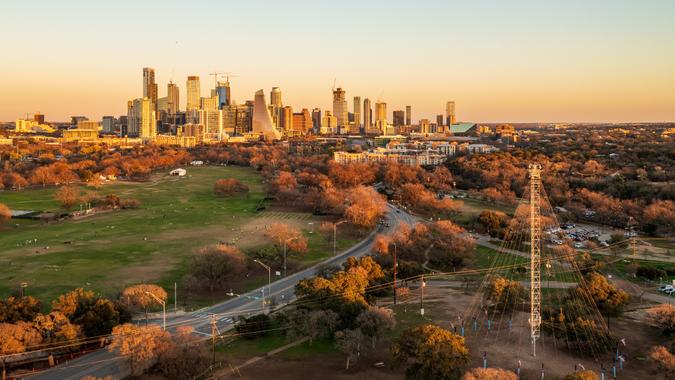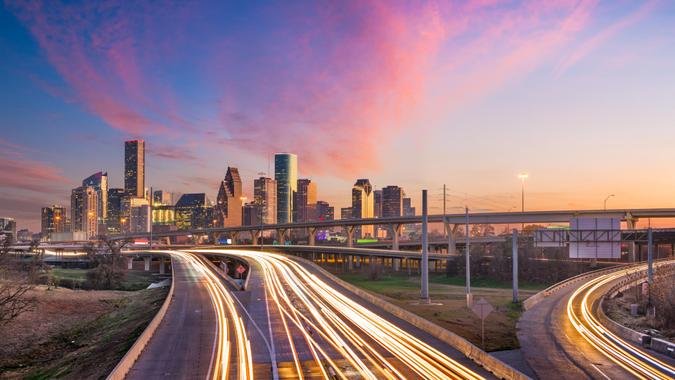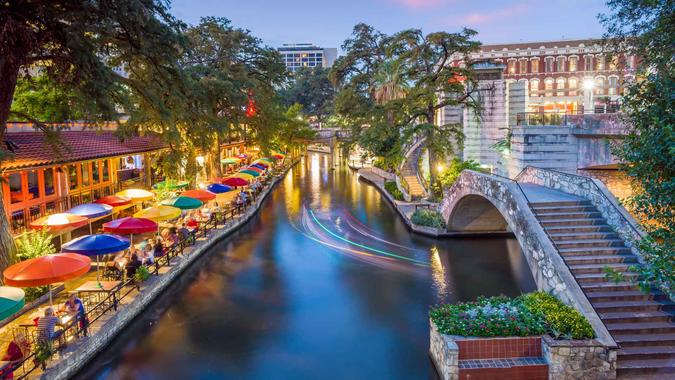
A salary of $100,000 can mean different things to different people — especially those who live in some of the biggest cities in America. In some cities, $100,000 is enough to keep the lights on and leave enough for savings and luxuries. In other cities, however, $100,000 is sometimes not even enough to break even.
Also See: Here’s the Line Between Middle Class and Upper-Middle Class in Every State
Learn More: 7 Ways To Tell If You're Rich or Middle Class -- It's More Than Your Paycheck
While $100,000 annually might not get you far in New York City, it’s certainly more than enough for the seven biggest cities in Texas.
That’s what GOBankingRates discovered recently when it analyzed just how far $100,000 would stretch in America’s 50 most populous cities. While certain states contained a number of cities in which $100,000 never feels like quite enough, each of the Lone Star State’s seven most populous cities leaves $100,000 earners quite a bit of pocket change by the end of the year. That’s partially because it’s one of the few states without an income tax; further, Texas’ cost of living is below that of the rest of the country.
Here’s a countdown of just how far $100,000 will go in Texas’ seven largest cities, counting down from the least amount of leftover money to the most.

7. Dallas
- Population: 1,299,553
- $100K after taxes: $78,509
- Annual expenditures: $46,135
- Income left after expenditures: $32,374
Dallas has a cost of living just slightly higher than the national average, thanks to property and sales taxes; that said, the costs of such daily necessities as utilities and gas there fall below the national averages. That allows residents who make $100,000 annually to stretch their salaries so that $32,374 is left after the bills are paid.
Check Out: Here’s the Minimum Net Worth To Be Considered Upper Class in Your 50s
Find More: What Is the Estimated Median Income for the Upper-Middle Class in 2025?

6. Arlington
- Population: 394,769
- $100K after taxes: $78,509
- Annual expenditures: $46,083
- Income left after expenditures: $32,426
Arlington is nearly identical to Dallas in terms of annual expenditures (Dallas costs $46,135, Arlington costs $46,083).
Discover More: What Salary Single People Need To Live Comfortably in 100 Major US Cities

5. Fort Worth
- Population: 941,311
- $100K after taxes: $78,509
- Annual expenditures: $45,720
- Income left after expenditures: $32,789
Fort Worth, with annual grocery costs at approximately $5,940 and an average rent level of $1,700, is slightly more affordable than Dallas. Residents making a $100,000 salary are able to pocket $32,789 after bills and taxes.

4. Austin
- Population: 967,862
- $100K after taxes: $78,509
- Annual expenditures: $45,527
- Income left after expenditures: $32,982
Austin’s cost of living is roughly 3% lower than the national average (though housing, specifically, is about 3% more expensive). The city’s annual expenditures of $45,527 leave folks in the $100,000 bracket with nearly $33,000 for discretionary spending.

3. Houston
- Population: 2,300,419
- $100K after taxes: $78,509
- Annual expenditures: $44,841
- Income left after expenditures: $33,668
Housing expenses are 20% less than the American average — that’s just one of the perks of living in Houston. The rather affordable metropolis allows those who make at least $100,000 to really stretch their salaries.
Read More: 3 Signs You’ve ‘Made It’ Financially, According to Financial Influencer Genesis Hinckley

2. El Paso
- Population: 648,147
- $100K after taxes: $78,509
- Annual expenditures: $42,541
- Income left after expenditures: $35,978
El Paso has slightly higher transportation expenses than the national average, but the city more than makes up for that fact with housing expenses that are 30% cheaper than the rest of the nation. The overall cost of living is 12% less than the U.S. average.

1. San Antonio
- Population: 1,458,954
- $100K after taxes: $78,509
- Annual expenditures: $40,953
- Income left after expenditures: $37,556
In San Antonio, Texans who make $100,000 get to keep well over $37,000 by the end of the year. That is plenty of cash to put aside for things like retirement funds, investments or exploring the city’s rich arts and culture scene (like the Alamo, the San Antonio Riverwalk and the Tower of the Americas).
Methodology: In order to find how far a salary of $100,000 goes in the 50 most populated cities in the United States, GOBankingRates sourced [1] the most populated cities from the U.S. Census 2023 American Community Survey, [2] grocery cost index, [3] healthcare cost index, [4] utilities cost index, [5] transportation cost index, [6] miscellaneous cost index (all sourced from Sperling’s BestPlaces). Using the [7] average expenditure costs for each category for consumer units earning $70,000 to $99,999 (via the 2023 Bureau of Labor Statistics Consumer Expenditure Survey_, the average annual expenditures were calculated. The [8] average rental cost was sourced from Zillow Observed Rental Index from June 2025 data and added to the annual expenses to find the total cost of expenses for each city. Using in-house calculations for each city, the take-home pay after taxes was tallied. By removing the annual total cost for expenses, we can find out just how far a salary of $100,000 goes in these cities. All data was collected on and is up to date as of Aug. 12, 2025.
More From GOBankingRates
This article originally appeared on GOBankingRates.com: How Far a $100,000 Salary Goes in Texas’ 7 Largest Cities







